
"The first step to protecting our planet is to learn more about it. With a true understanding of the natural world, we can take from the earth without destroying it...Our planet is the only home we have. It is precious and needs our care. The power to protect our earth rests with each of us. You could say that the world's future is truly in the palms of your hands."
- Rachel Ignotofsky
We recently took an incredible trip to Oceania. Would you like to do the same? We'll show you how to gather up some animal friends, make a passport, and embark on an exciting journey to one of the coolest and most diverse places on earth. Sound like fun?
Alright then, let's explore this Oceania continent study and the largest coral reef in the world.
As our 3-year-old likes to say, "Follow my leader!"
Disclosure of Material Connection: Some of the links in the post are “affiliate links.” This means if you click on the link and purchase the item, I will receive an affiliate commission. Amazon links are not affiliate links. You can read my full affiliate disclosure.
What is Oceania?
Oceania is a geographical region that consists of Australasia, Melanesia, Micronesia, and Polynesia. It includes thousands of islands in the central and South Pacific. Australasia is where Australia is located. (National Geographic Resource Library)
What is a Biome?
As defined in The Wondrous Workings of Planet Earth: Understanding Our World and its Ecosystems by Rachel Ignotofsky, a biome is "a region defined by a specific climate (its temperature and precipitation) and certain types of animals and plants that have adapted to survive and thrive in that specific climate."
We are using mostly materials from Waseca Biomes in this Oceania continent study. The Waseca Biomes curriculum classifies the biomes as you see in the map legend image below. These include ocean, polar regions, temperate forests, deserts, grasslands, mountains, tropical forests, and wetlands.
You may see this classification system broken down further in other science materials, depending on the topic of study.
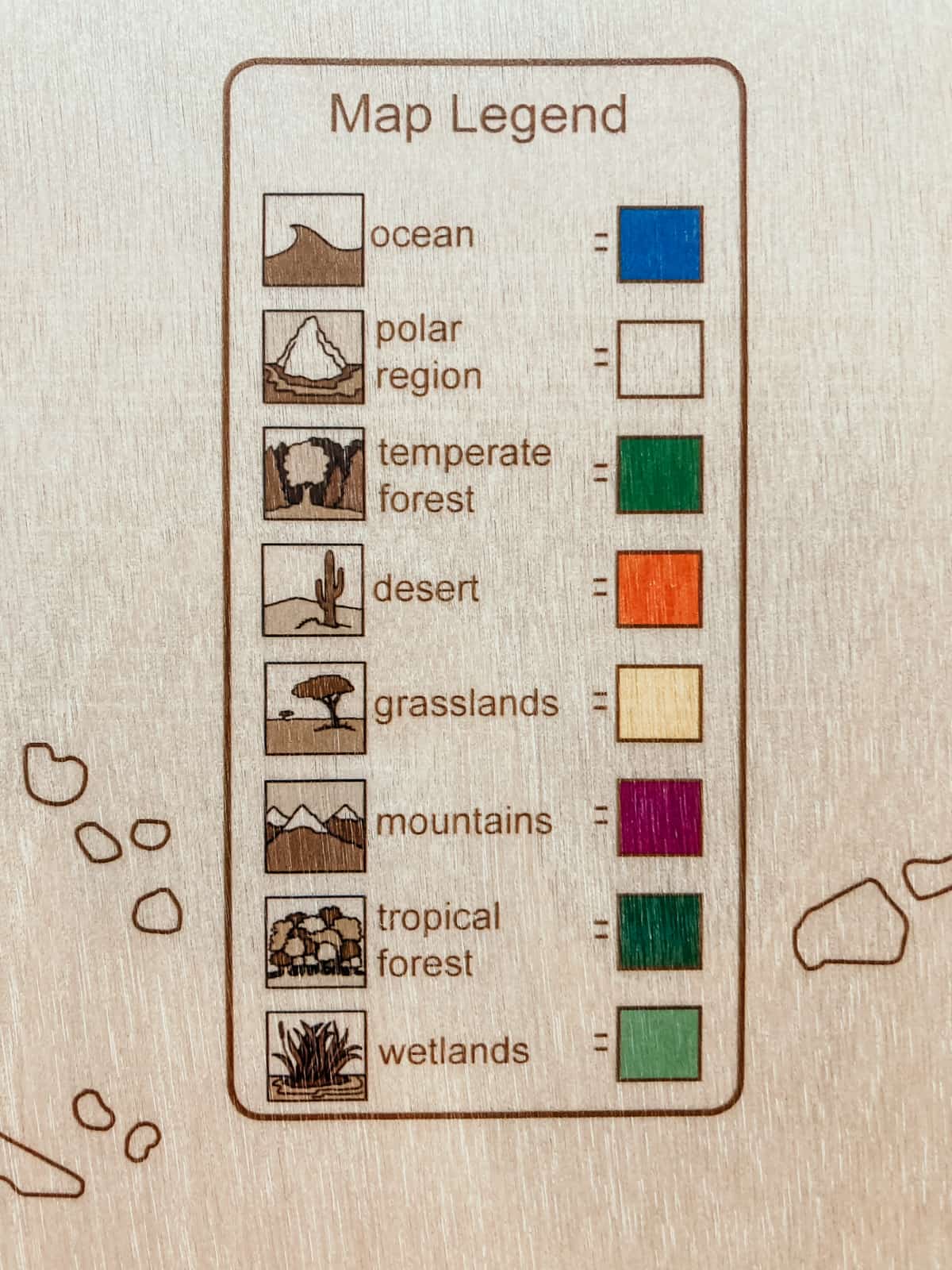
How Many Biomes Are There in Oceania?
Including our exploration of The Great Barrier Reef, we are exploring seven biomes in this continent study. Now that's a lot of diversity in one geographical region.
The only biome not applicable to Oceania is the polar region.
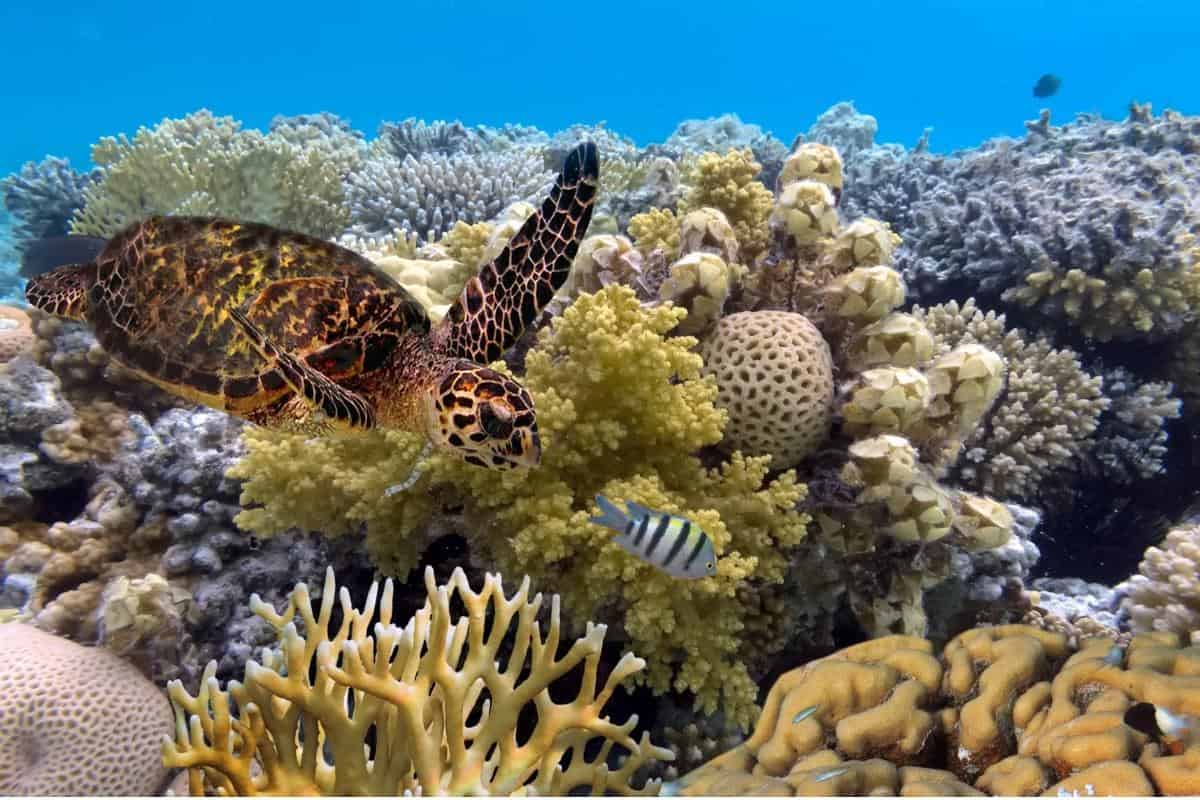
What is the Largest Coral Reef in the World?
The largest coral reef in the world is The Great Barrier Reef. It's located off the northeastern coast of Australia. As we learned in Ocean Anatomy by Julia Rothman and as stated in its name, The Great Barrier Reef is a barrier reef as opposed to a fringing reef or atoll. In other words, it grows parallel to Australia's coastline, and deep water is located between it and Australia's coast.
The Wondrous Workings of Planet Earth: Understanding Our World and its Ecosystems by Rachel Ignotofsky describes The Great Barrier Reef in detail:
"The Great Barrier Reef comprises over 600 different types of corals, creating colorful tunnels and towers of various shapes and sizes. All of these nooks and crannies make inviting habitats for thousands of other marine plants and animals. Schools of tropical fish, seahorses, stingrays, sharks, whales, and even the seabirds flying above all depend on the Great Barrier Reef, making it the most biodiverse ecosystem in the whole ocean."
Rachel Ignotofsky
Who Will Benefit From This Oceania Continent Study?
This continent study is curated specifically for preschool through elementary learners. However, from toddlers through elementary students and all the way to adults, there's something in this Oceania continent study for everyone.

Oceania Continent Study & The Great Barrier Reef
This Oceania continent study includes a mix of hands-on materials, books, and printables. There are even free resources included. You will find opportunities for imaginative play, art, reading, writing, grammar, science, geography, and more as you explore Oceania.
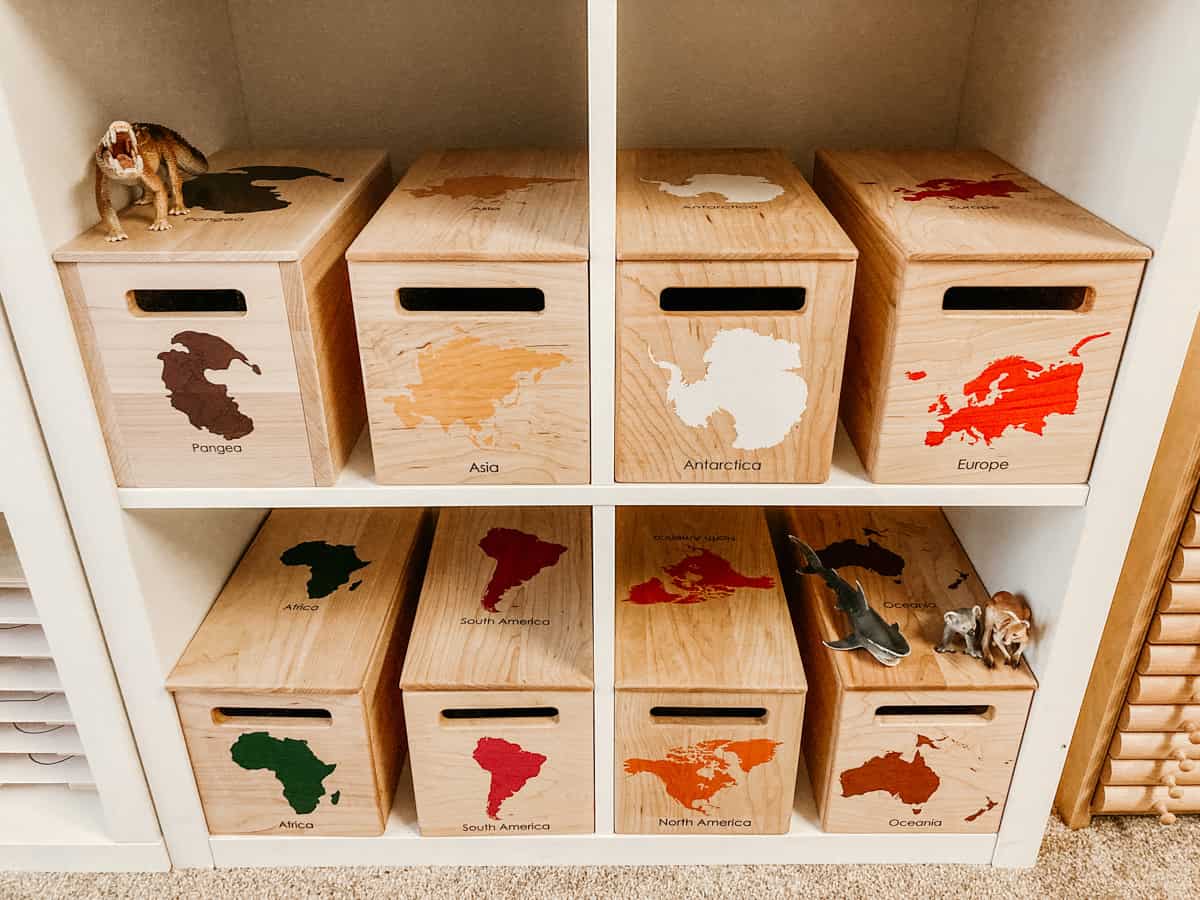
Explore the Oceania Continent Box Materials
We include Schleich animals for every continent along with postcards and other printable resources. You'll find a FREE cooking resource to put inside your Oceania continent box down at the bottom.
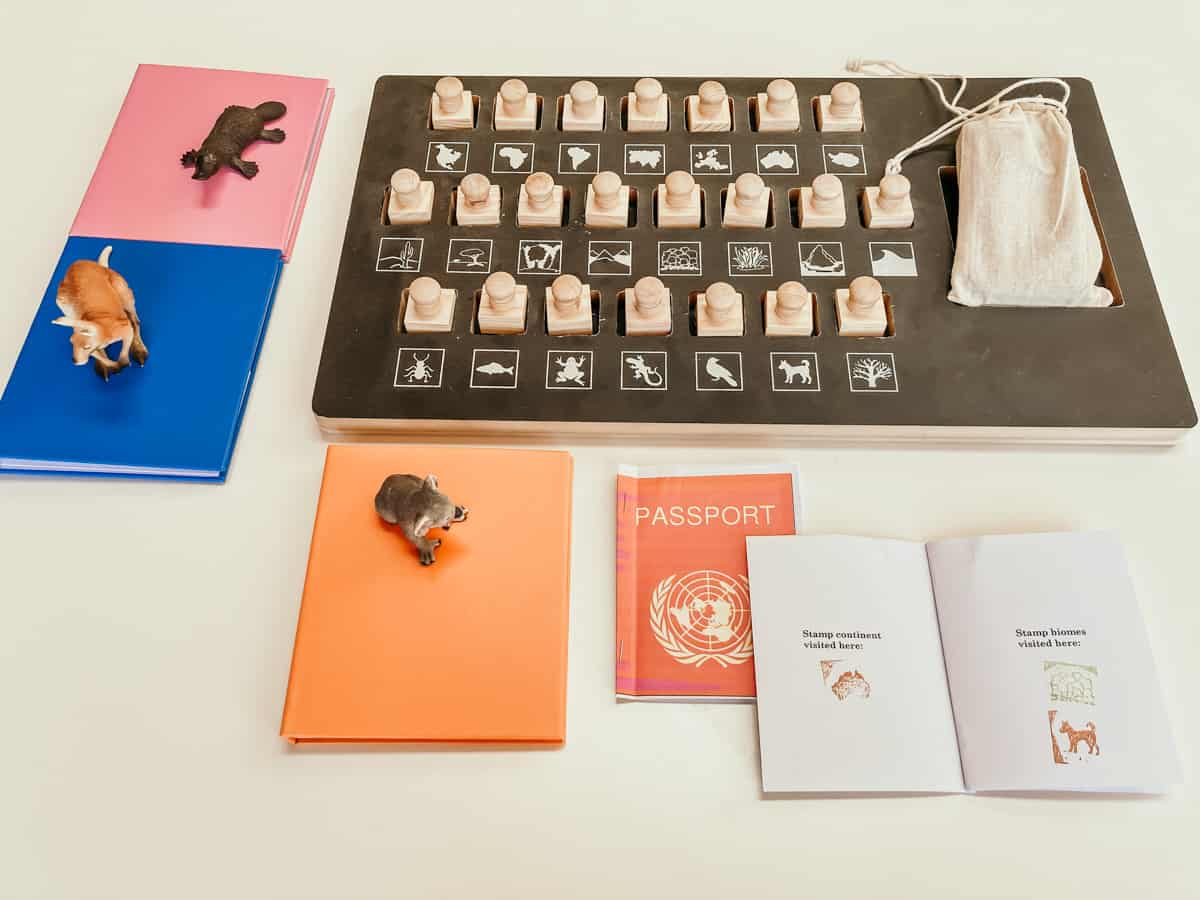
Stamp Your Passport & Continue the Learning Journey
- Waseca Biomes Oceania Readers
- Waseca Biomes Biome Stamps
- Waseca Biomes Passport (FREE)
- Schleich Australian Animals (kangaroo, platypus, and koala pictured)
Get a $15 coupon towards your first Waseca Biomes purchase.
On this particular day, our kids chose to learn about the koala, kangaroo, and platypus, all of which are mammals. They began by stamping their passports with the continent stamp, the biome stamp, and the animal classification stamp for the koala.
This is an excellent activity for reinforcing knowledge of the symbols used throughout the Waseca Biomes materials. Our son noticed he used the rainforest stamp for the koala when he originally thought it was the temperate forest stamp. Having that built-in self-correction is what makes these materials ideal for learners.
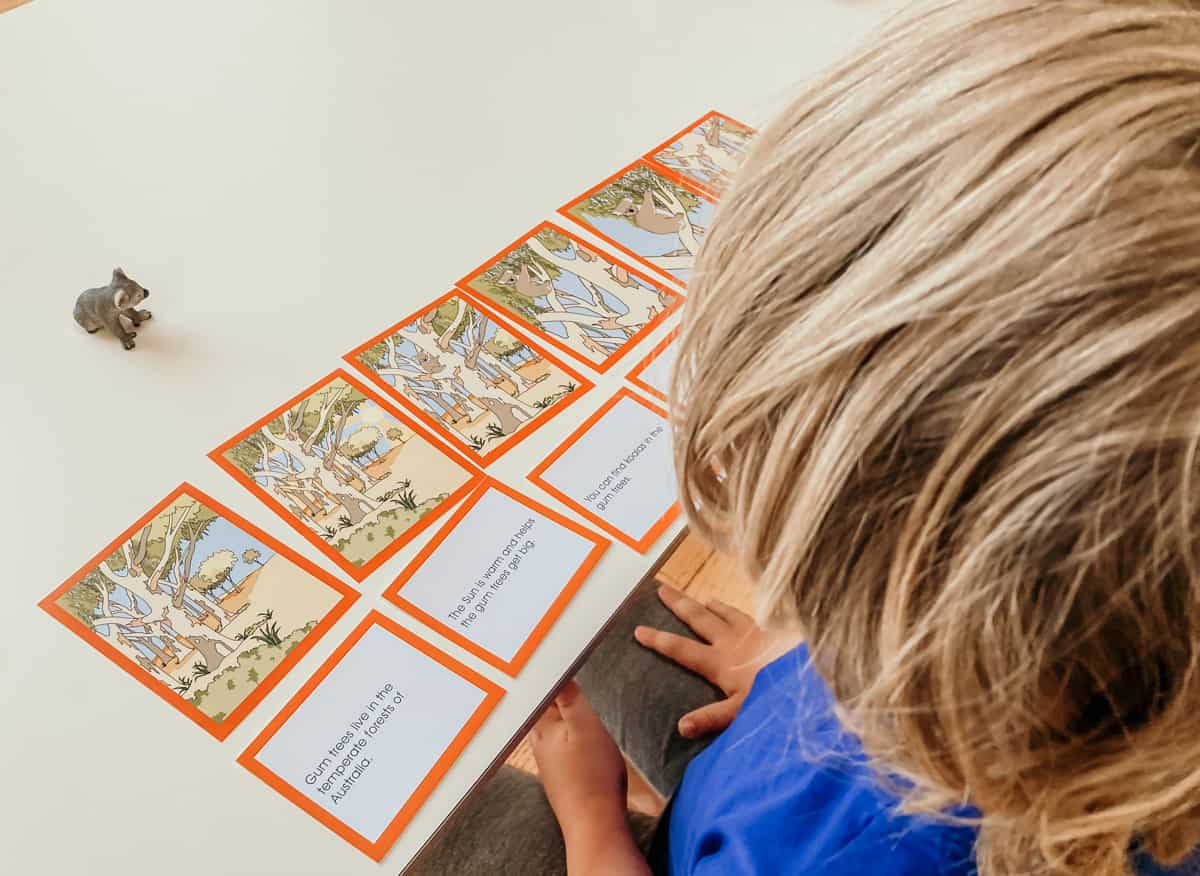
The Oceania Continent Readers support a hands-on approach to literacy that pair well with the Waseca Biomes Reading Program.
Kids read the unillustrated booklets in the reader, lay out the picture cards in sequence, and then match the text cards to the appropriate picture cards. Numbers are on the back of each card for self-correction.
There are also free masters available on the website to extend the learning.

Oceania Animal Classification - Mammals
- Cosmic Montessori School Animal Classification Nomenclature Cards (FREE)
- Handmade Felt Nomenclature Card Holder
Did you know that the duck-billed platypus is a very unique mammal in that it lays eggs? That's pretty cool and something that, in addition to its bill, really added to our kids' excitement when learning about the platypus.
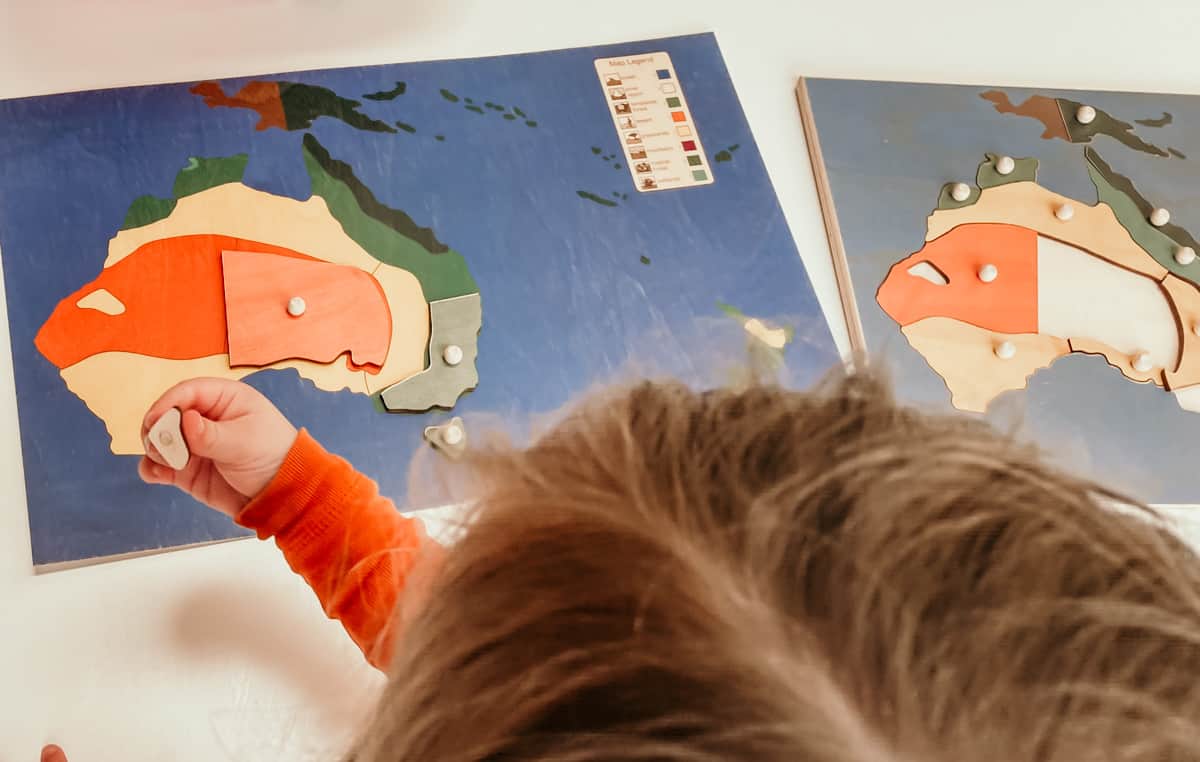
Oceania Continent Puzzle
Get a $15 coupon towards your first Waseca Biomes purchase.
Preschoolers and up can explore the map and biomes of Oceania using the Oceania Biome Puzzle.

Our preschooler is matching the biome puzzle pieces to the full-color veneer control chart. She then puts the puzzle back together and uses the control chart to check her work.

Oceania Continent Stencil
Get a $15 coupon towards your first Waseca Biomes purchase.
This Oceania continent stencil is awesome and our 4 and 6 y.o. both enjoy creating their own maps.
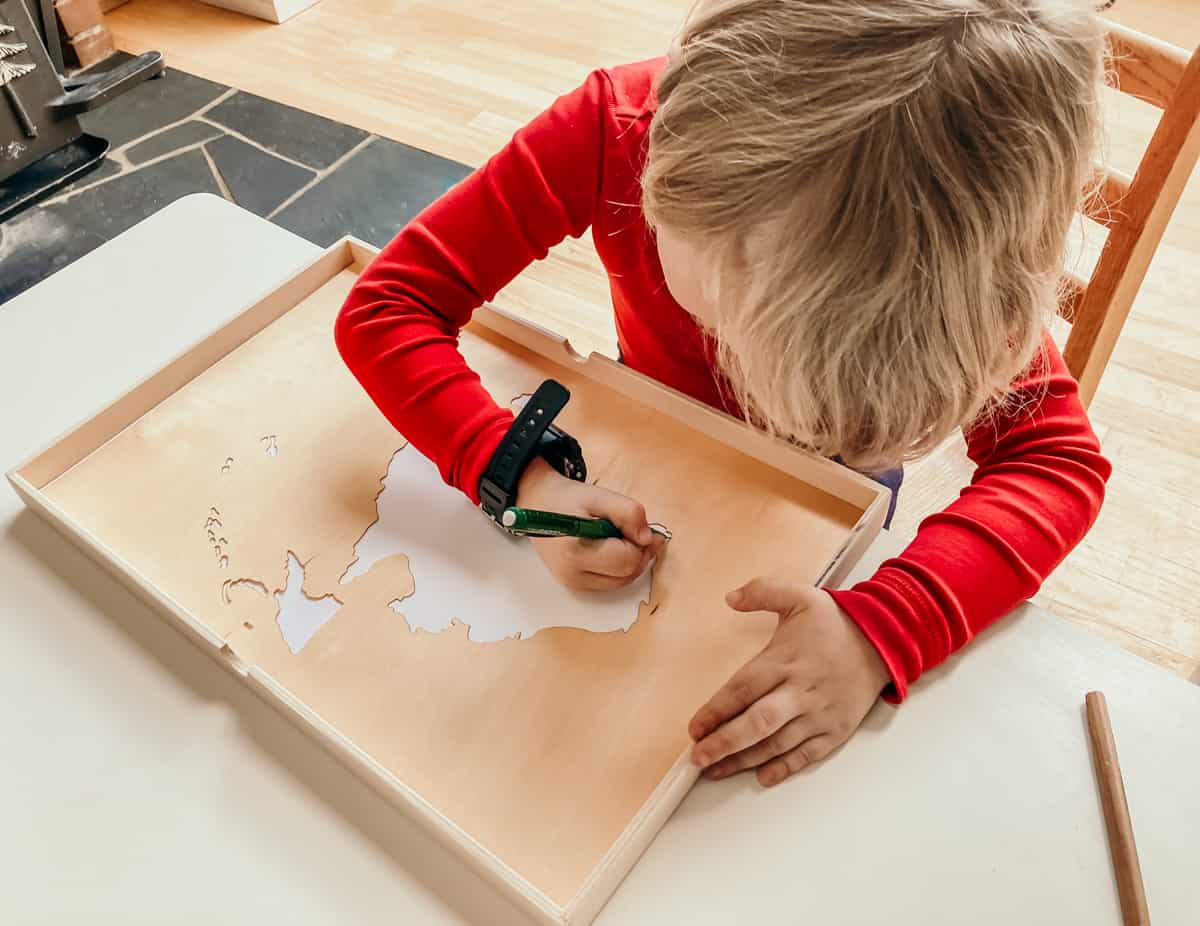
First, the continent shape is traced using the continent outline stencil.

Afterward, the mountains and rivers are added using the stencils provided.

A stamp of this map legend is used to create a custom legend for the Oceania stencil.
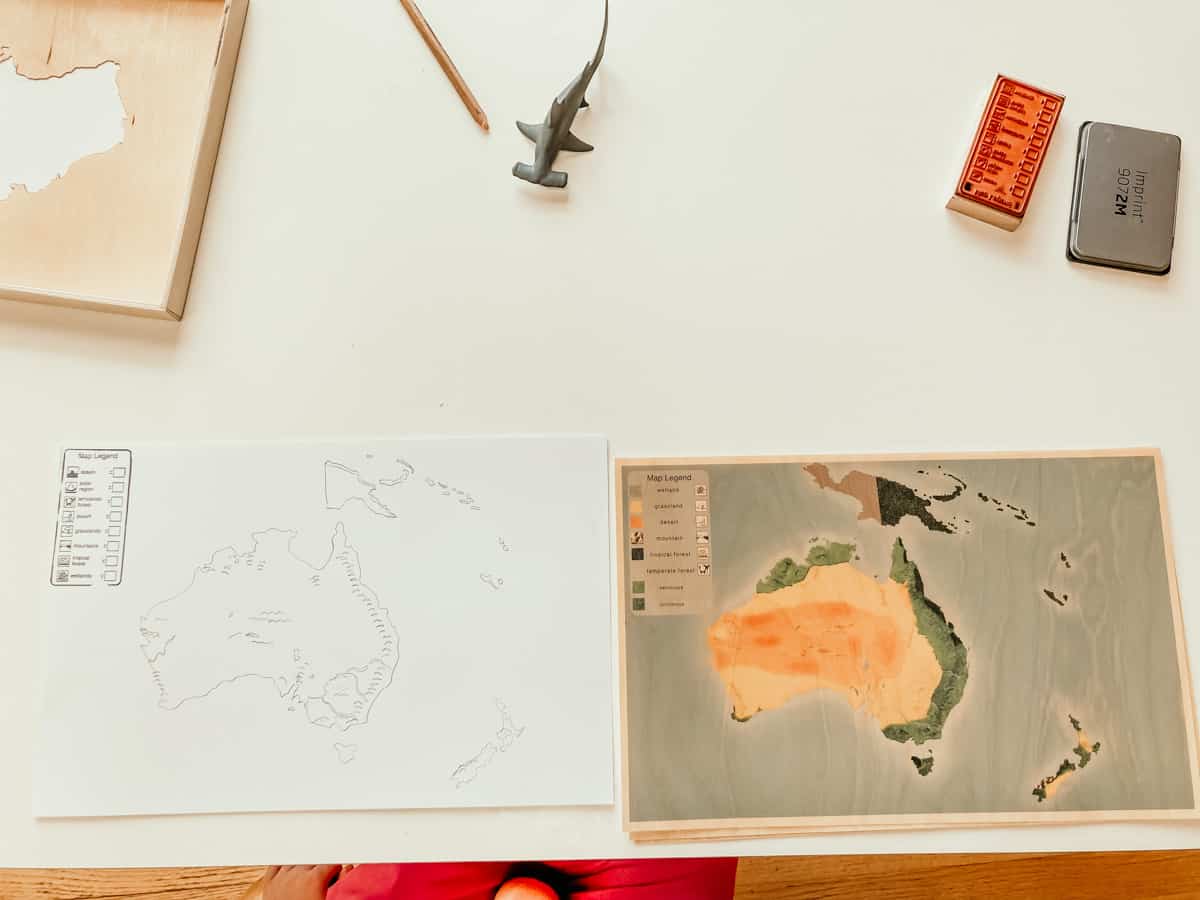
Get a $15 coupon towards your first Waseca Biomes purchase.
Finally, the map legend is ready to be colored in along with the biomes of the continent. Labels of features can also be added.
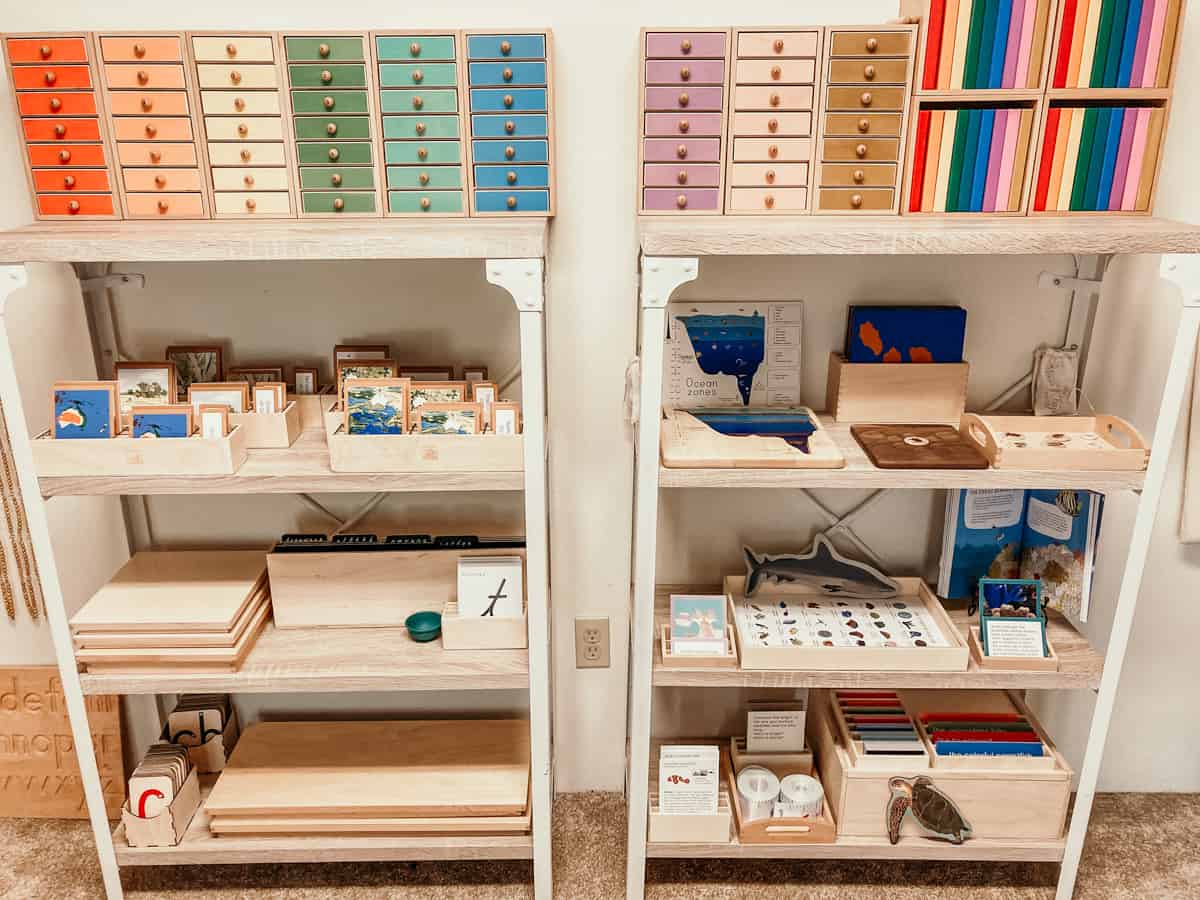
Oceania Language, Geography & Science Shelves

Get a $15 coupon towards your first Waseca Biomes purchase.
The Oceania Biome Cards include people and animals of the biomes cards as well as guidance on how to use them and skills the child will gain as they complete the activities.
Our oldest is starting with the cursive boards on these shelves and the biome cards are the perfect inspiration for handwriting practice.
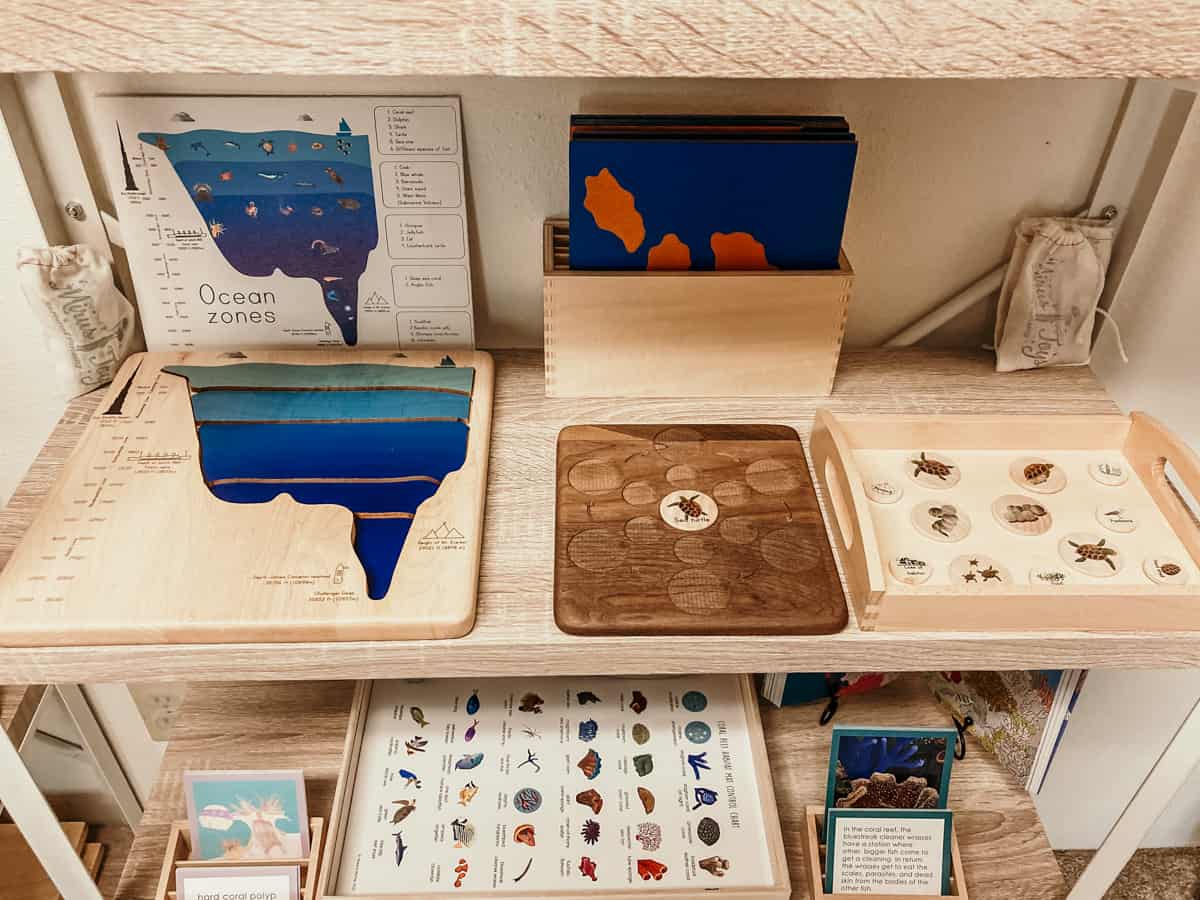
- Mirus Toys Zones of the Ocean Puzzle
- Mirus Toys Life Cycle Board and Sea Turtle Coins
- Mirus Toys Ocean Food Chain Coins
- Montessori Land Form Cards
The puzzle and life cycle board strengthen fine motor skills in addition to teaching kids about marine life.
The life cycle board comes with 1 set of coins. Additional coin sets are sold separately to extend the learning opportunities.
The land form cards will help kids identify land forms of Oceania.
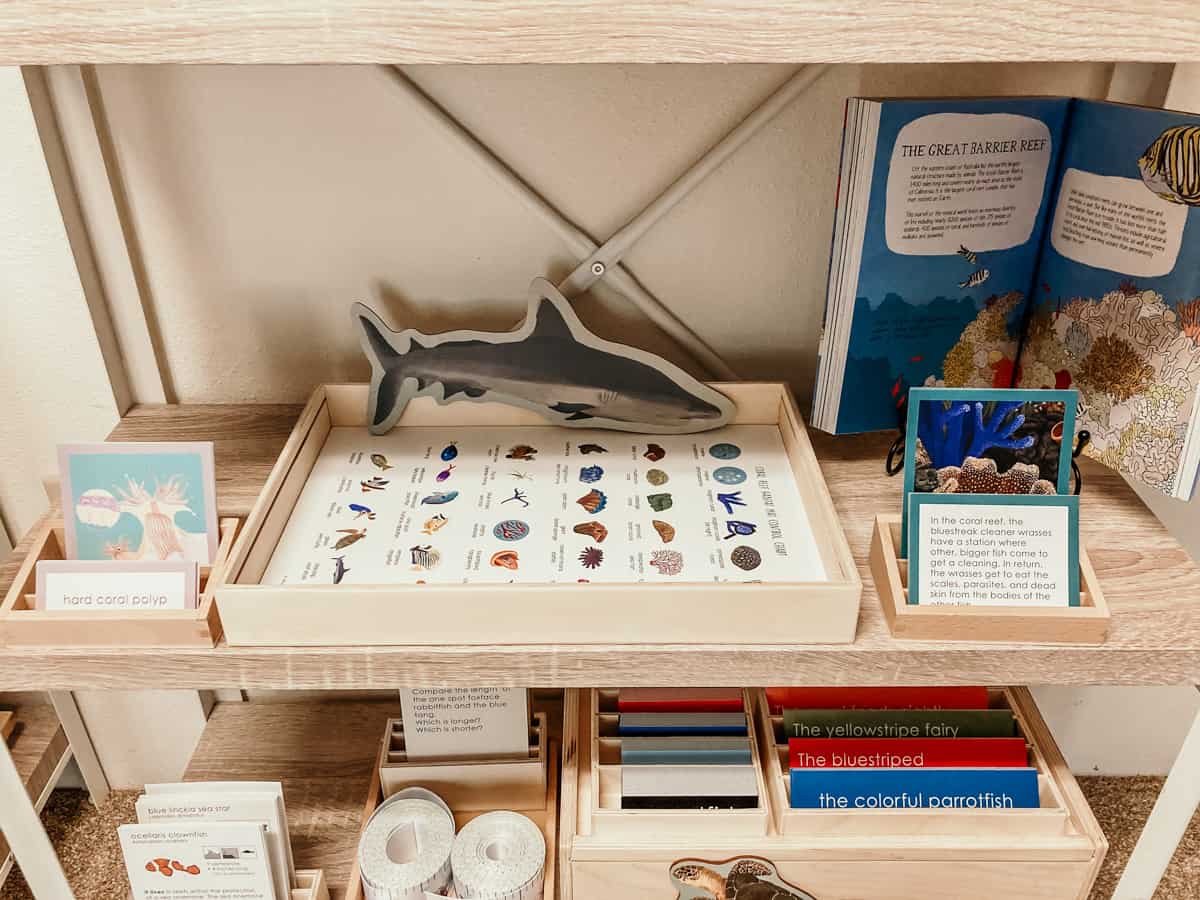
Get a $15 coupon towards your first Waseca Biomes purchase.
Are you kids interested in corals or marine life? If so, the Coral Reef Habitat Mat is a must-have.
This mat has 9 presentations, including grammar and math works, so there are plenty of skills for kids to practice while learning about this exciting and diverse ecosystem.

Here are more materials for the Coral Reef Habitat Mat and the wooden storage box that comes with it.

Oceania Biome Mat, Coral Reef Habitat Mat & Grammar Materials
Get a $15 coupon towards your first Waseca Biomes purchase.
The Oceania Biome Mat will give kids another close-up look at the physical geography of Oceania while teaching them the names of important places and features.

- Waseca Biomes Coral Reef Habitat Mat
- Schleich Marine Animals
- Treasures From Jennifer Oceania Continent Box
The Montessori continent box, Schleich animals, Atlas of Ocean Adventures, and the Coral Reef Habitat Mat provide countless opportunities for exploring The Great Barrier Reef, corals, and other marine life.

Get a $15 coupon towards your first Waseca Biomes purchase.
These grammar symbols are to be used with many of the Waseca Biomes Grammar Mats, including the Coral Reef Habitat Mat.
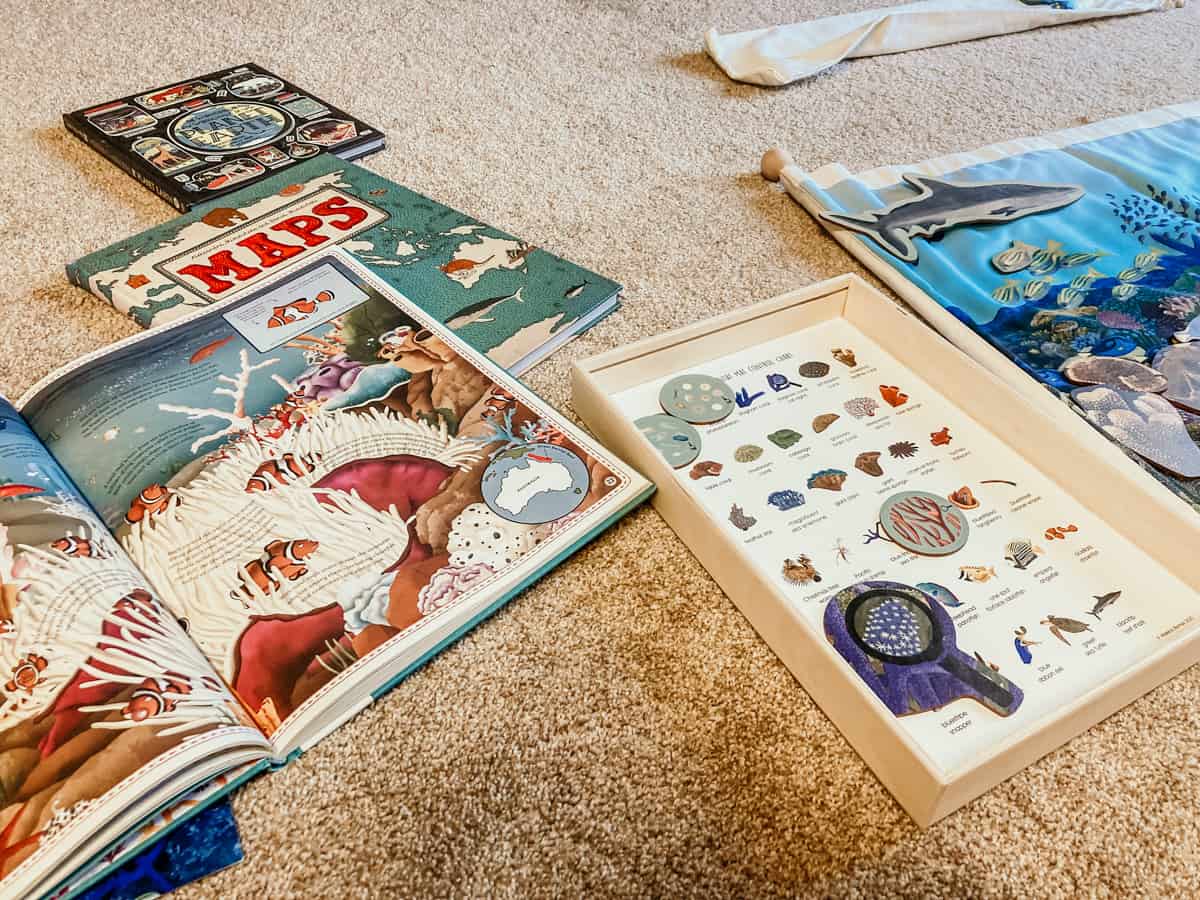
Books for Oceania Continent Studies
- Atlas of Ocean Adventures
- Atlas of Animal Adventures
- Maps
- The Wondrous Workings of Planet Earth
- Ocean Anatomy
- Natural World: A Visual Compendium of Wonder from Nature
- Under the Canopy
- Cabinet of Curiosities
- Inside In: X-Rays of Nature's Hidden World
- Animalium
- Oceanarium
- Wild Animals of the South
- Mountains of the World
- A Life Like Mine
Would your kids like to learn more about Oceania and all their favorite topics?
Discover Uluru/Ayers Rock and its significance to Aboriginal people as a holy place by exploring Mountains of the World by Dieter Braun.
Find out which tree is responsible for giving the Blue Mountains of Australia their name in Under the Canopy.
There's plenty to discover using these beautiful books and many will remain helpful as interest is ignited when exploring other parts of the world. You can also find these books and more in our shop.

These large and beautiful illustrations by Lucy Letherland in Atlas of Ocean Adventures bring the ocean to life in our homeschool.

Oceanarium is large enough for everyone to gather around and enjoy the vivid illustrations as we explore the diversity of the coral reef ecosystem. This book is a must-have resource for investigating the world's oceans.

Math Activities with The Coral Reef Habitat Mat
Get a $15 coupon towards your first Waseca Biomes purchase.
Compare the sizes of your favorite coral reef animals using the wooden animals and the animals of the world measuring tape. This is a perfect hands-on approach for animal lovers to practice measurement skills.
This same activity can be completed with the Schleich animals in your Oceania continent box.
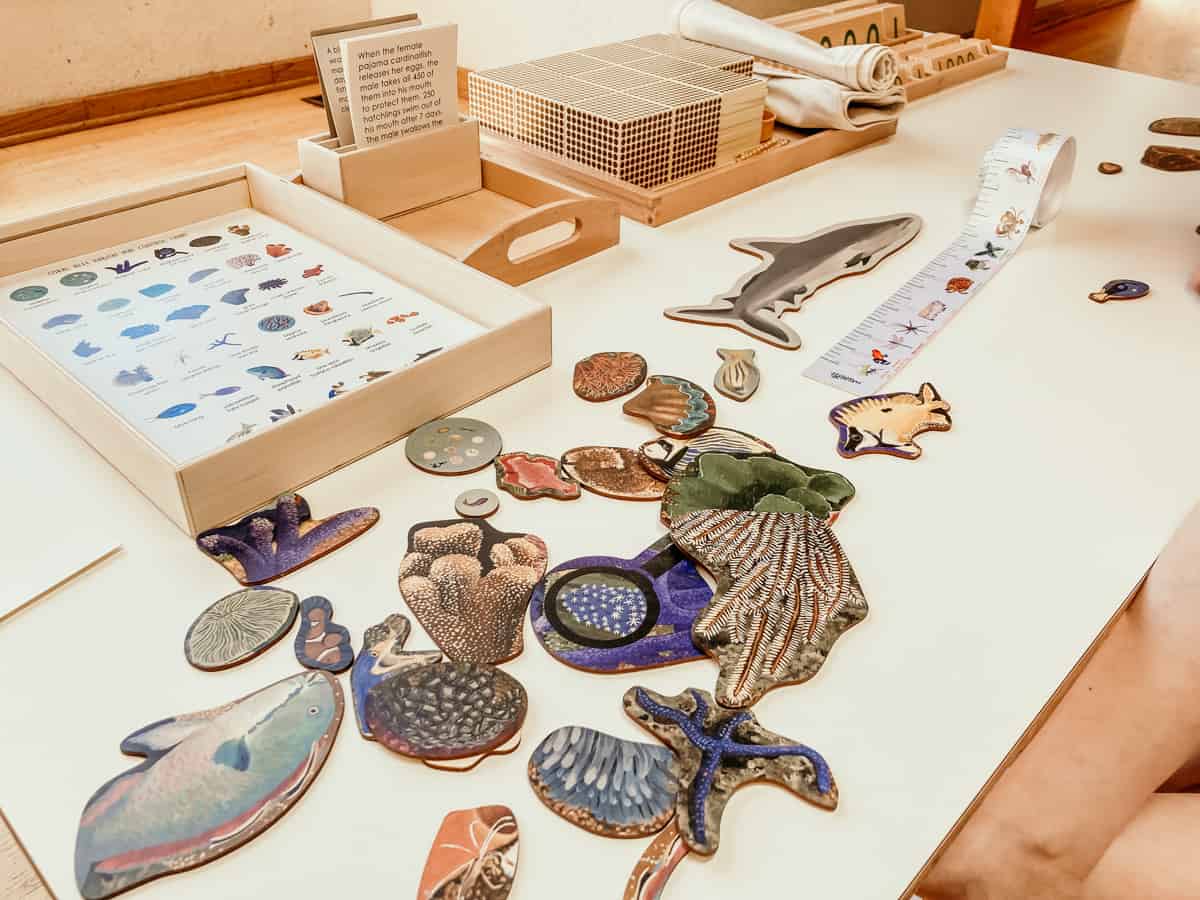
- Montessori Golden Bead Material (Sold individually or as a set)
- Montessori Large Wooden Numeral Cards
The Coral Reef Habitat Mat is advertised for ages 6-12 but we've found that our 4-year-old enjoys a few of the math activities as well.
Here is a setup on a table for practicing a variety of skills using the Coral Reef Habitat mat.

- Montessori Place Value Mat {Similar}
Our son reviewed the decimal system with the Montessori golden bead material before moving on with two of the subtraction word problems. Children may also want to use a place value mat for reviewing nomenclature prior to completing some of the word problems.
Kids can also practice with the stamp game or the bead frame using this Coral Reef Habitat Mat as they show readiness. Moving from the golden beads to the stamp game to the bead frame is an example of how Montessori math focuses on moving from concrete materials toward abstraction.
Our kids will frequently move between these materials as they are introduced to new ones.

Here is a wooden pajama cardinalfish from the Waseca Biomes Coral Reef Habitat Mat and the subject of one of their word problems.
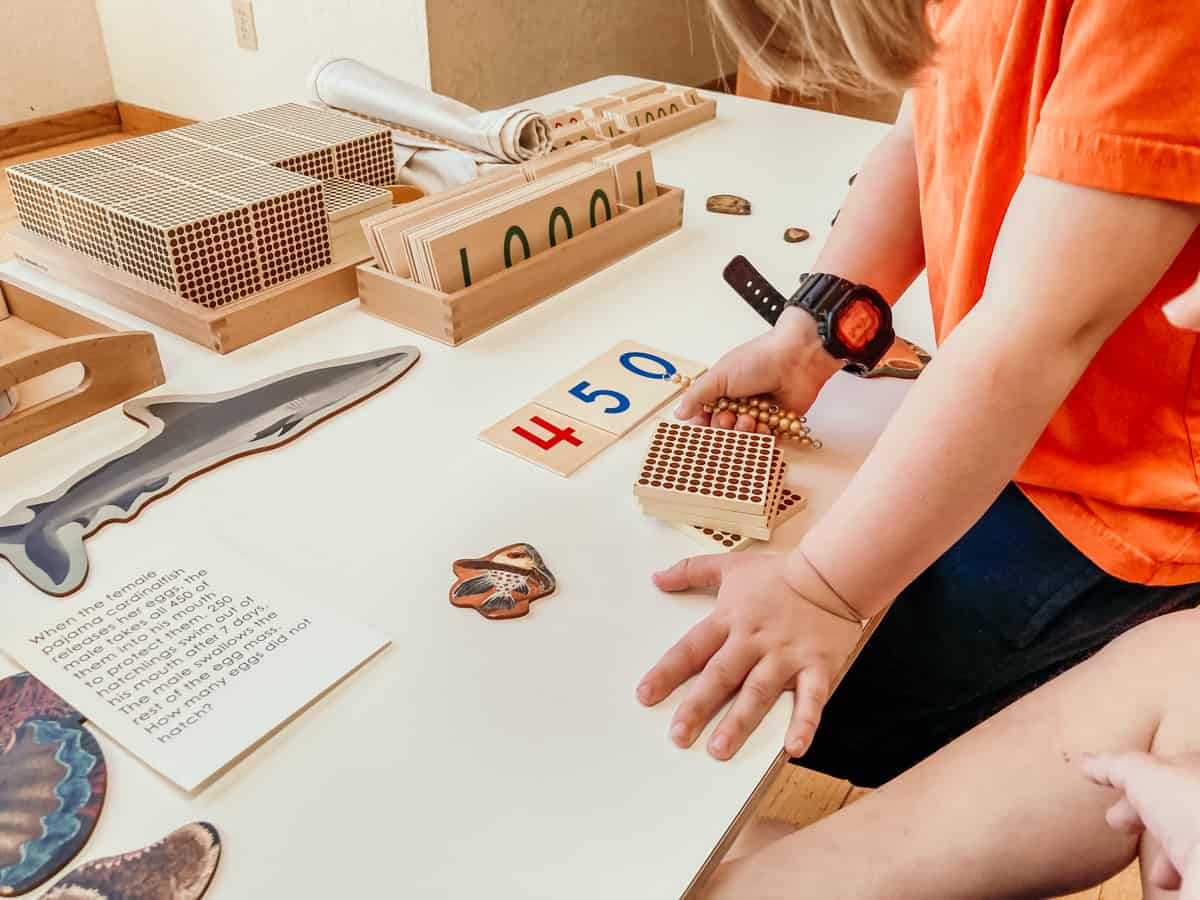
Our oldest daughter read the problem aloud and our son acted the problem out with the golden beads before settling into completing the problem. Lots of fun!
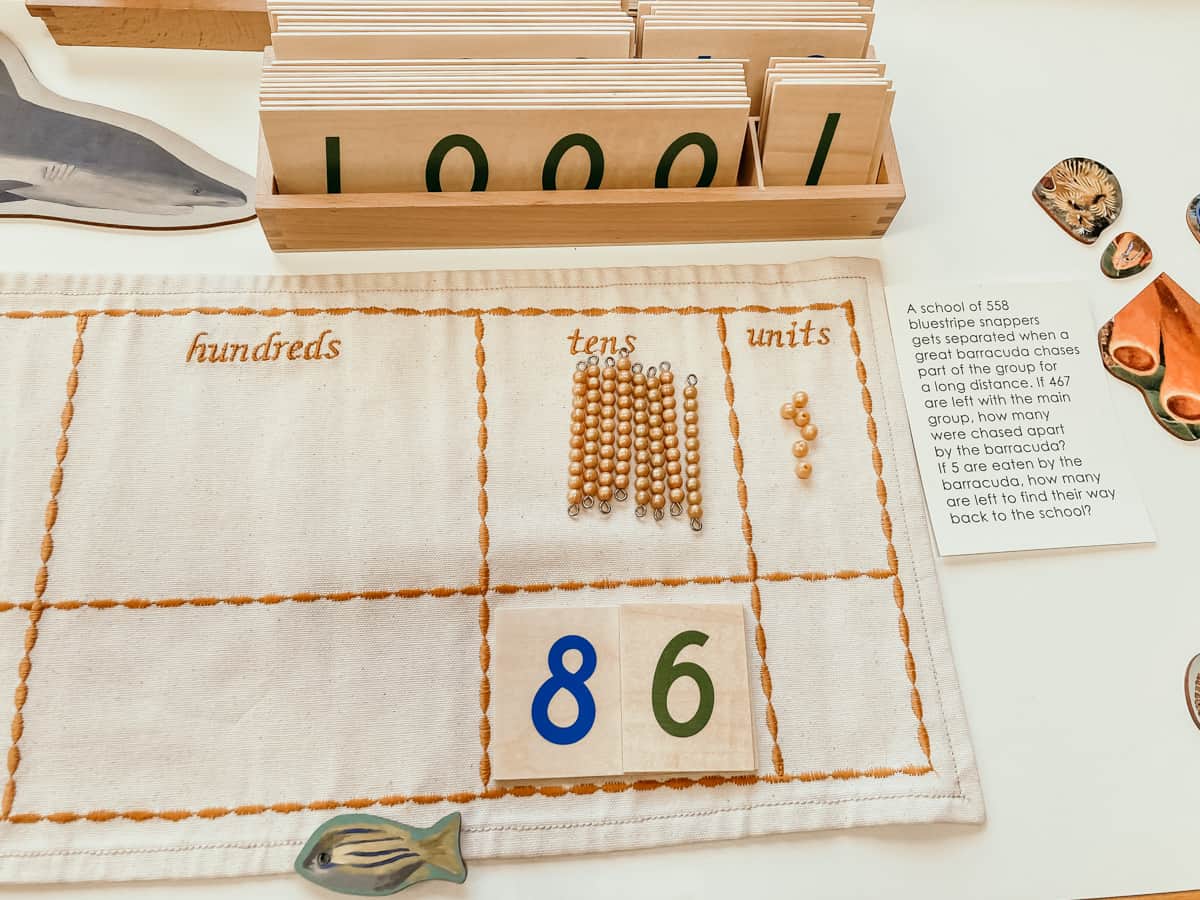
2-Part Word Problem
Here, you can see our son completed a 2-part subtraction word problem using the golden beads and the place value mat. Once he concluded how many units and tens were left, he performed the "magic slide" with the numeral cards to arrive at the final answer.
After calculating the remaining bluestripe snappers, he and our daughter decided to look up more information about the exciting barracuda that's chasing the fish away.
Many of the math activities are geared toward our oldest daughter but this is an example of how versatile this mat is, even for younger kids.

Hands-On Exploration of Corals
- Fossilicious Paleontology for Kids Book and Fossil Set (Corals book pictured)
We haven't had this Paleontology for Kids Book and Fossils Set for long, but we keep running into excellent uses for it as we cover new topics. In this case, you can explore corals, sharks, prehistoric marine life, and more as you learn about fossils.
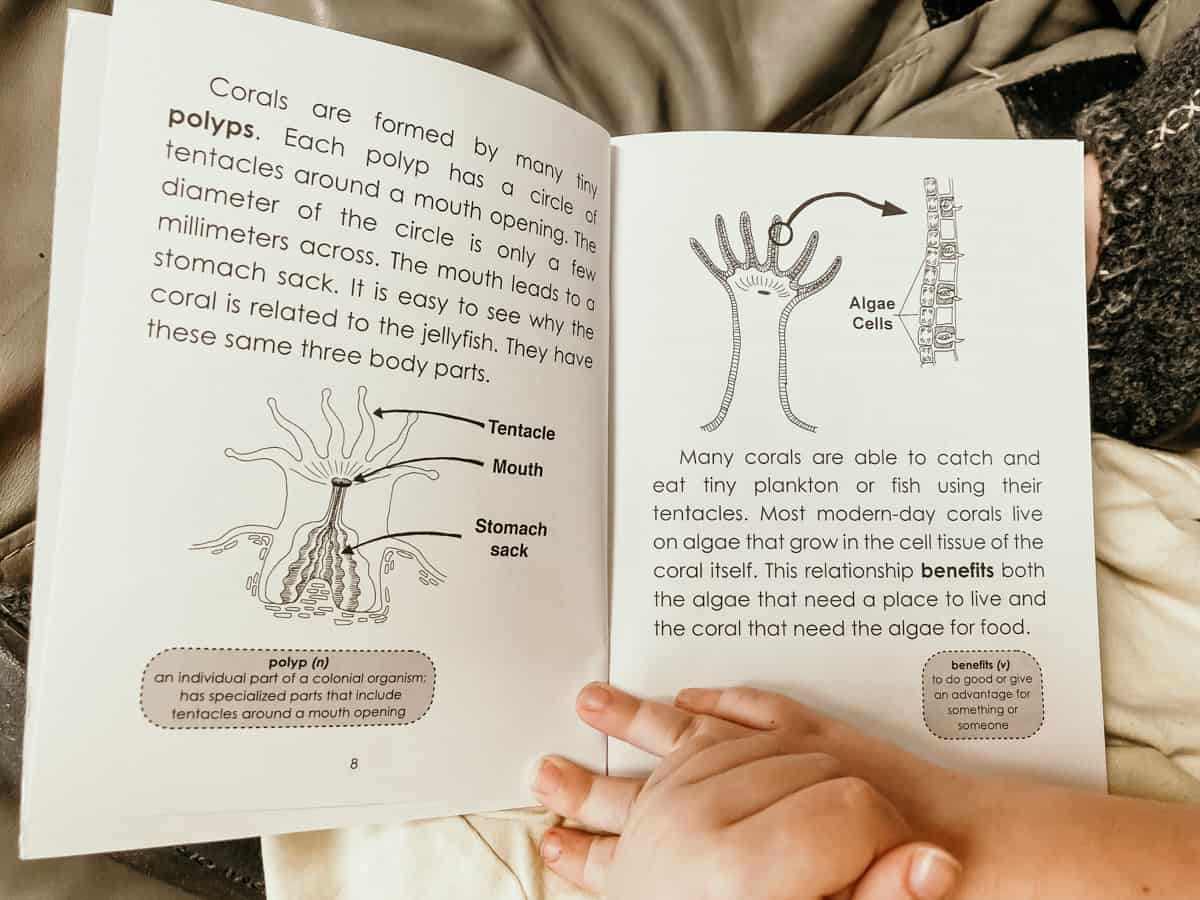
This section of the Corals book by Fossilicious describes the parts of a coral polyp as well as the relationship between algae and corals.

These Fossilicious fossils are just some of the samples kids can explore when learning about our earth. This is an exciting hands-on opportunity for kids and adults.
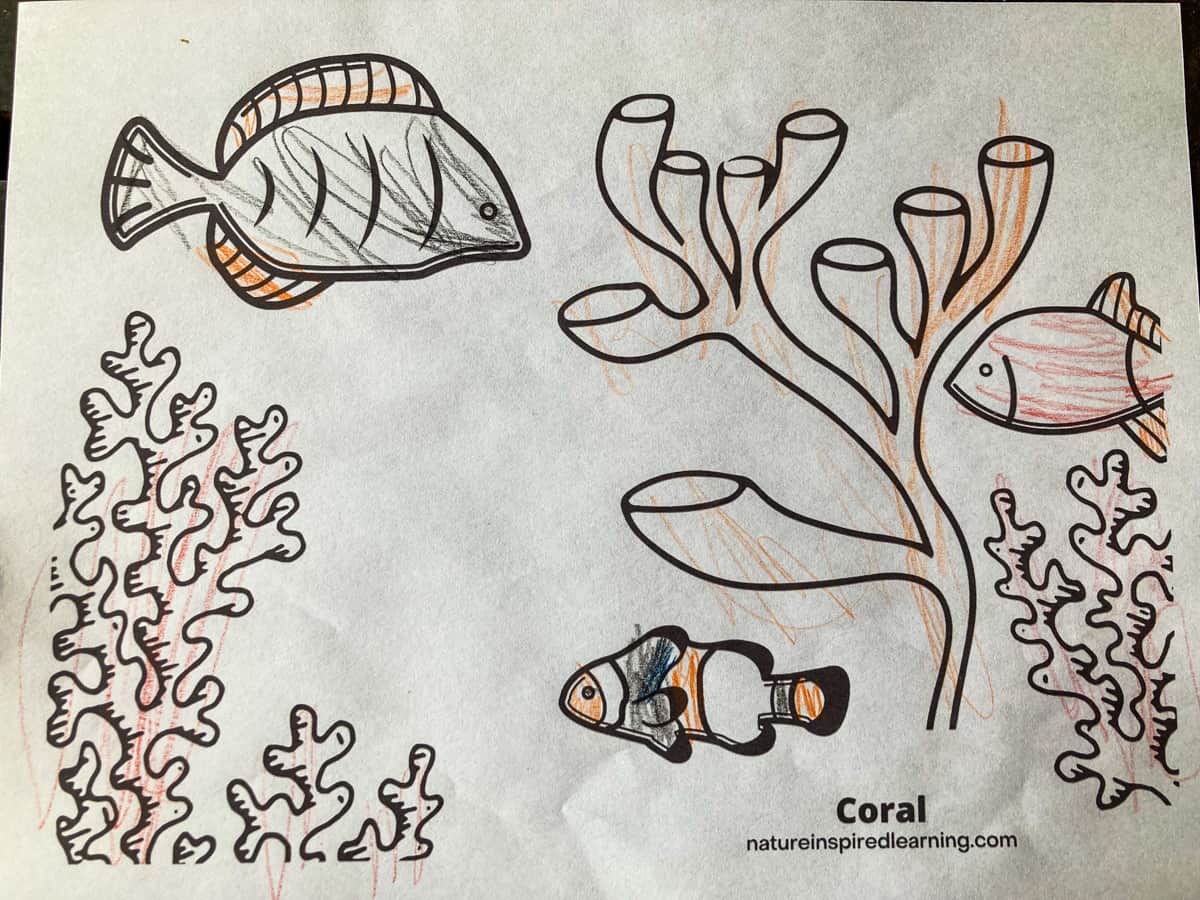
Coloring Pages for Coral Reef Habitats
- Nature Inspired Learning Coral Reef Coloring Pages (FREE)
- Nature Inspired Learning Sea Turtle Coloring Pages (FREE)
These Nature Inspired Learning coloring pages are free and fun for all ages. There are also opportunities for handwriting practice included.

Oceania Portfolio for Elementary
Get a $15 coupon towards your first Waseca Biomes purchase.
Elementary learners can explore Oceania with native guides and practice their navigation skills while completing various activities and research projects.
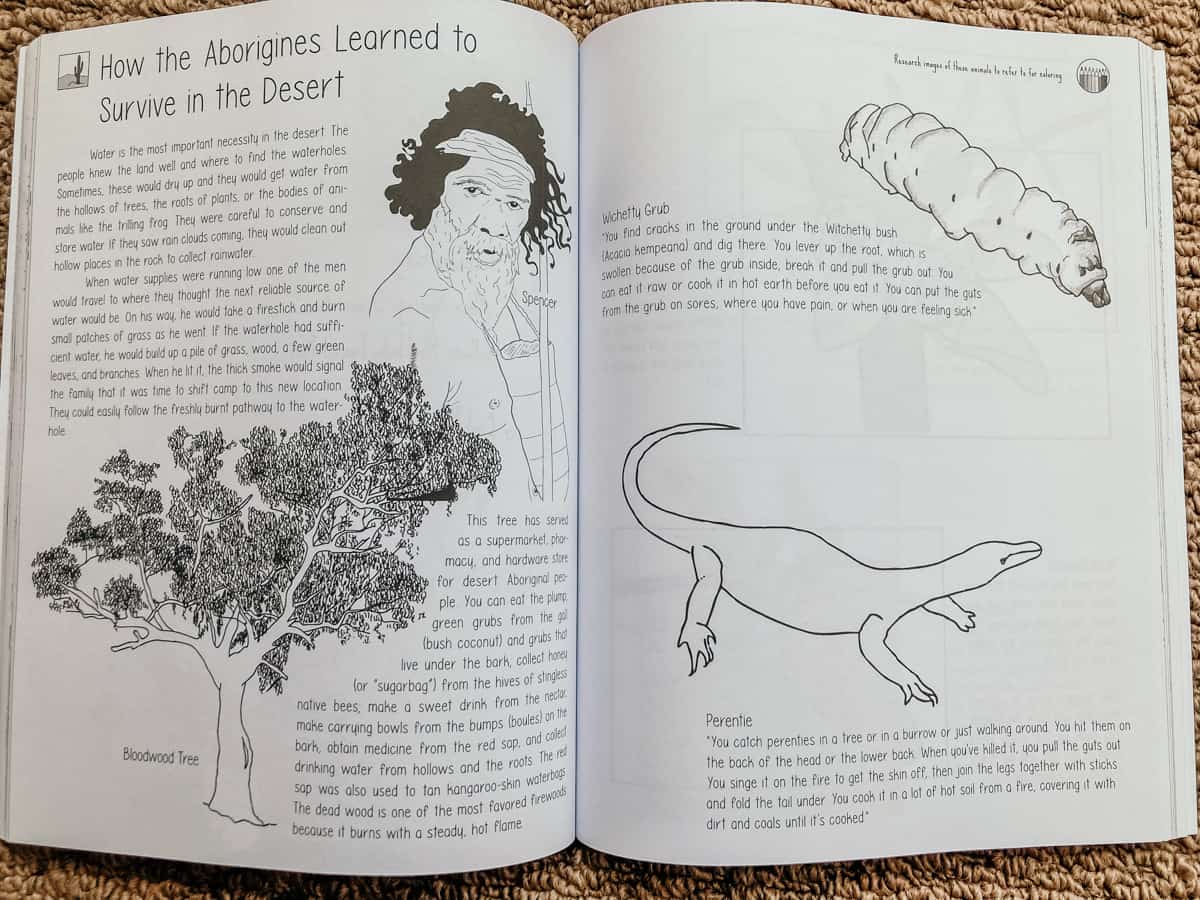
Learn exciting facts about Australia and Oceania, including how the Aborigines learned to survive in the desert.

Want to explore animal adaptations? Would your kids like to research the colors of some of their favorite animals? Research prompts gives kids ideas and nurture creativity.
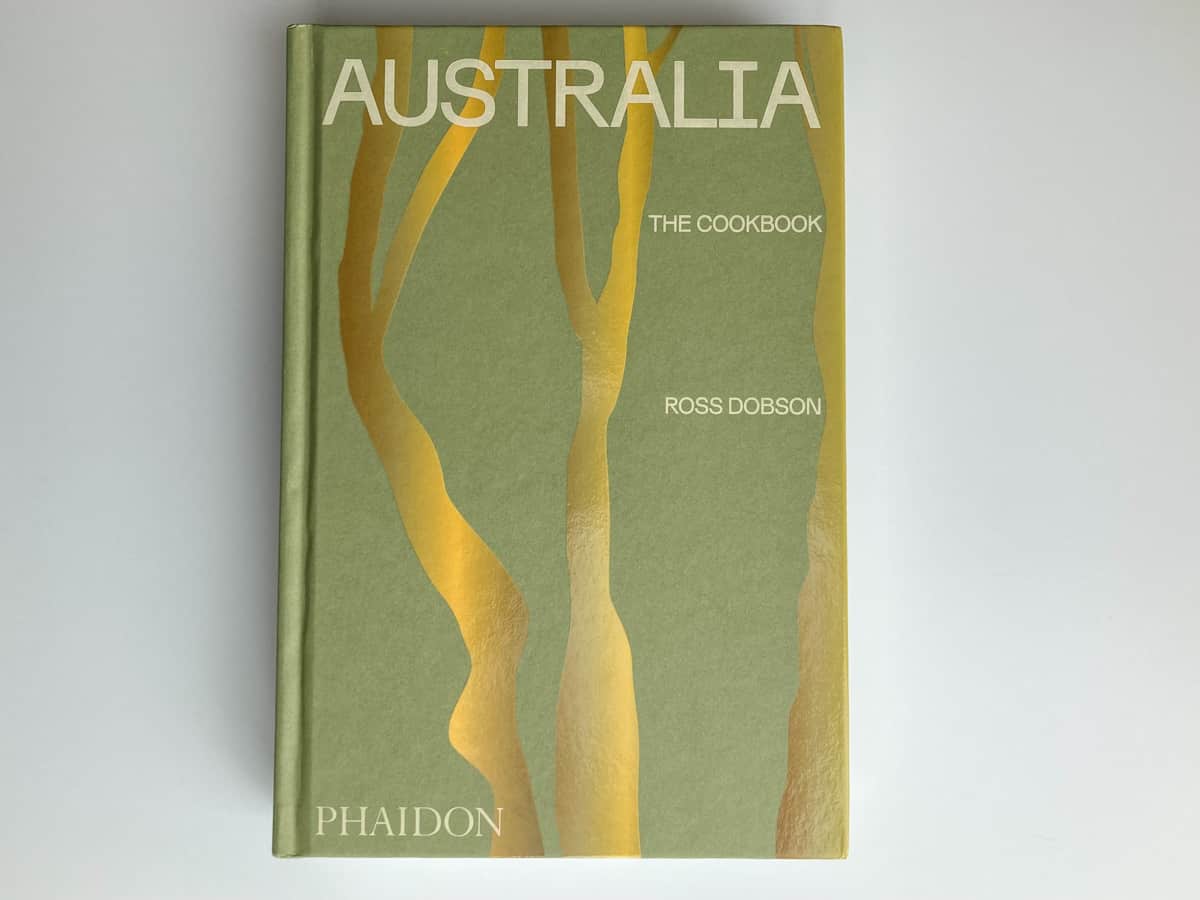
Practical Life in the Kitchen
Kids can learn life skills while exploring geography and history using Australia: The Cookbook by Chef Ross Dobson. It includes 350 recipes across 3 distinct time periods in Australia's history.
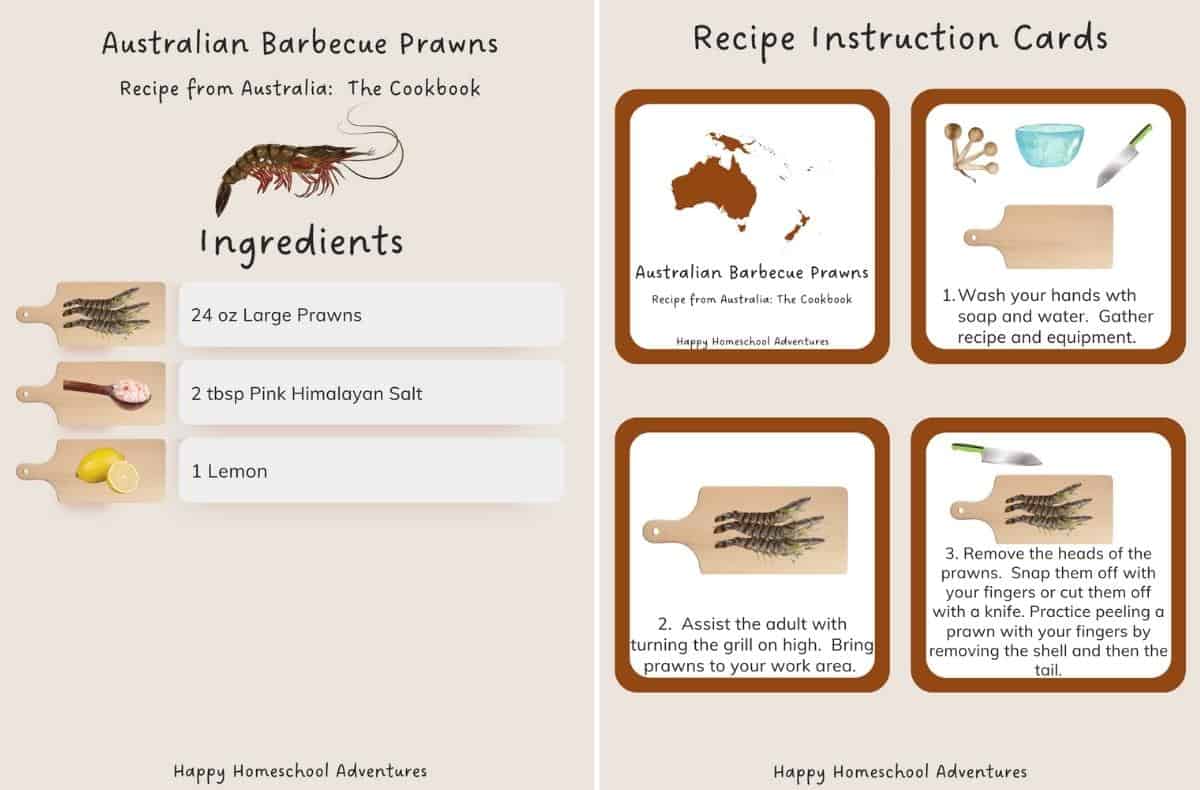
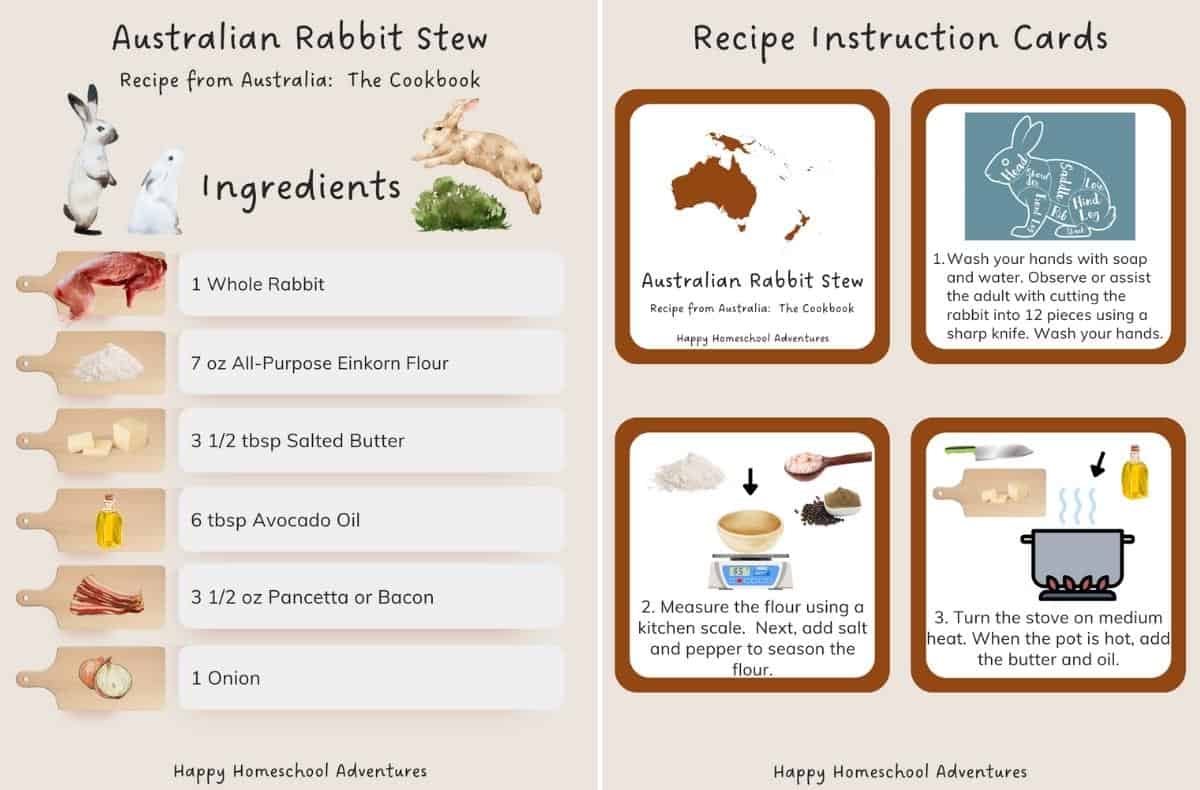
Free Australian BBQ Prawns and Rabbit Stew Recipes for Pre-Readers and Up
Grab your free kid-friendly Australian recipes above. Children can gather ingredients using the ingredient list, gather tools using the tools list, and prepare the meal using the step-by-step recipe cards, with assistance as needed.
The cards are easy to use, they include pictures, and they encourage confidence and independence in the kitchen. They make an excellent addition to your continent box.
Conclusion
We enjoyed our trip to Oceania and the largest coral reef in the world. We hope your kids enjoy learning about Oceania and the Great Barrier Reef as well.
Many of the same resources exist for studying the other continents. Also, many of the books can be included in continent studies around the world.
What activities will resonate with your kids the most?
More Oceania Continent Resources
Get 16% off your purchase from Montessorikiwi here.
More Unit Studies
- Antarctica for Kids
- Bee Unit for Preschool & Elementary
- Rocks and Minerals & Fossils
- Tree Activities for Preschoolers
Oceania Continent Study
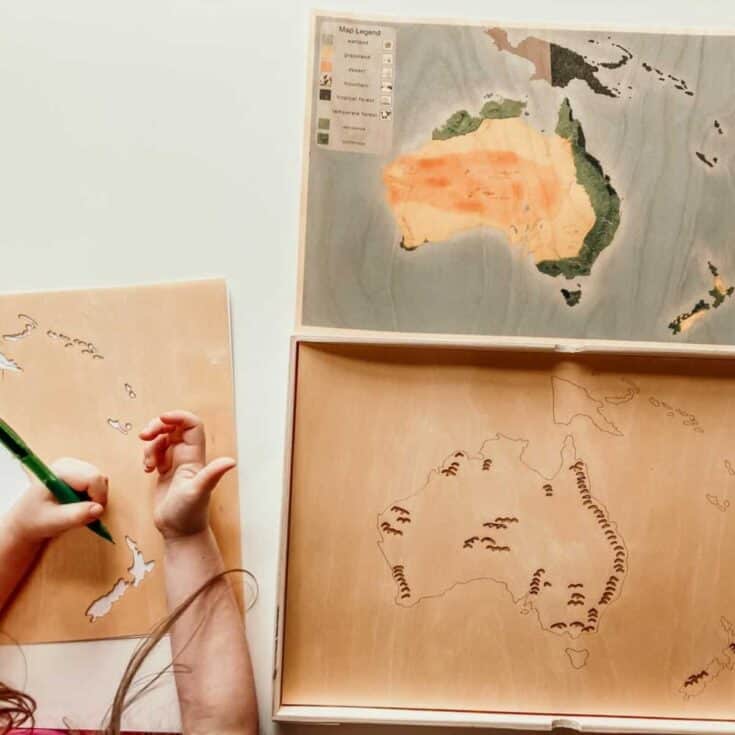
This Oceania continent study for preschool through elementary learners includes facts about Australia & the largest coral reef in the world.
It can also be used as a template for exploring other continents with preschool through elementary students.
Materials
- Atlas of Ocean Adventures
- Atlas of Animal Adventures
- Maps
- The Wondrous Workings of Planet Earth
- Ocean Anatomy
- Natural World: A Visual Compendium of Wonders from Nature
- Under the Canopy
- Cabinet of Curiosities
- Inside In: X-Rays of Nature's Hidden World
- Animalium
- Oceanarium
- Wild Animals of the South
- Mountains of the World
- A Life Like Mine
- Australia: The Cookbook
- Treasures From Jennifer Montessori Continent Boxes
- Schleich Australia Animals
- Schleich Marine Animals
- Waseca Biomes Oceania Readers
- Waseca Biomes Biome Stamps
- Waseca Biomes Passport (FREE)
- Cosmic Montessori School Animal Classification Nomenclature Cards (FREE)
- Handmade Felt Nomenclature Card Holder
- Waseca Biomes Oceania Biome Puzzle
- Waseca Biomes Oceania Stencil
- Waseca Biomes Map Legend Stamp
- Waseca Biomes Oceania Biome Cards - Primary
- Waseca Biomes Cursive Boards
- Mirus Toys Zones of the Ocean Puzzle
- Mirus Toys Life Cycle Board and Sea Turtle Coins
- Mirus Toys Ocean Food Chain Coins
- Waseca Biomes Coral Reef Habitat Mat
- Waseca Biomes Oceania Biome Mat
- Waseca Biomes Grammar Symbols
- Waseca Biomes Animals of the World Measuring Tape
- Waseca Biomes Oceania Portfolio
- Montessori Land Form Cards
- Montessori Golden Bead Material
- Montessori Large Wooden Numeral Cards
- Montessori Place Value Mat
- Montessori Stamp Game
- Montessori Bead Frame
- Fossilicious Paleontology for Kids Book and Fossil Set
- Nature Inspired Learning Coral Reef Coloring Pages (FREE)
- Nature Inspired Learning Sea Turtle Coloring Pages (FREE)
- Australian Barbecue Prawns Recipe (FREE)
Tools
- See Materials List
Instructions
- Explore the Oceania Continent Box materials, including the Schleich animals.
- Stamp your passport and continue the learning journey with the passport, stamps, animals, and Oceania readers.
- Provide animal classification nomenclature cards for the animals that kids are learning about. They make their own 3-Part Card holders using felt.
- Introduce the Oceania biome puzzle to preschoolers and up. Demonstrate how to self-correct using the control chart.
- Introduce the Oceania continent stencil to kids and provide plenty of time for kids to work on it. They can stop and come back to it as interest and time allow.
- Use the Oceania Biome Cards and Cursive Boards when exploring people and animals of the biomes.
- Introduce the Zones of the Ocean Puzzle and Life Cycle Board to explore the depths of the ocean and its inhabitants, including life cycles and food chains. The land form cards will help kids identify land forms of Oceania.
- Introduce the Oceania Biome Mat to give kids another close-up look at the physical geography of Oceania while teaching them the names of important places and features.
- Give the 9 presentations for the Coral Reef Habitat Mat using the materials provided along with the Animals of the World Measuring Tape, the Grammar Symbols, and the Montessori math materials. Provide plenty of time for practicing these lessons independently.
- Introduce books as kids show interest in various topics. Provide opportunities for independent exploration as kids draw connections between the books and their materials.
- Introduce the Paleontology for Kids Book and Fossils set to provide hands-on exposure to a sponge, clam, shark tooth, and several types of coral fossils. Encourage exploration of the books and fossils set as you cover applicable topics in your homeschool.
- Include a variety of coloring pages in the environment to spark interest in the Great Barrier Reef and coral reef habitats.
- Encourage elementary learners to explore the Oceania Portfolio to discover topics of interest and promote research.
- Extend the learning with practical life activities using the cookbook and the free barbecue prawns printable. Encourage kids to keep the recipe in their continent box.
Notes
Full Lesson Info and Pictures at: https://happyhomeschooladventures.com/oceania-continent




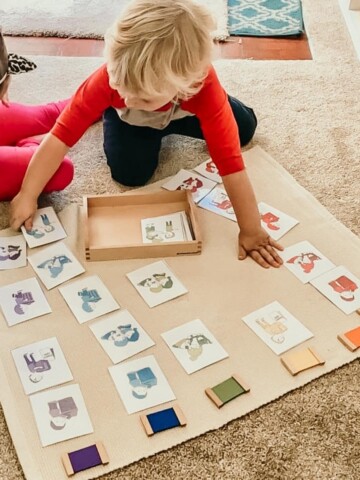
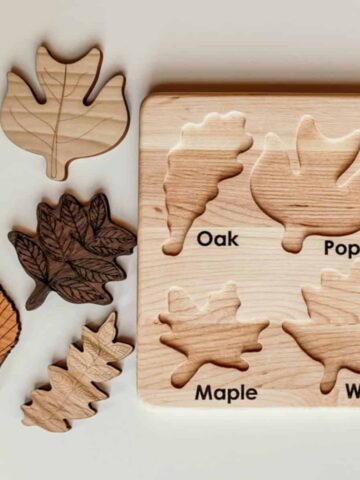
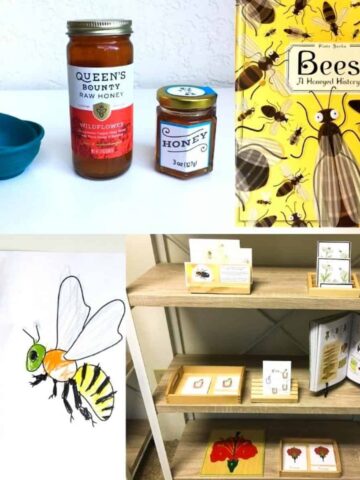
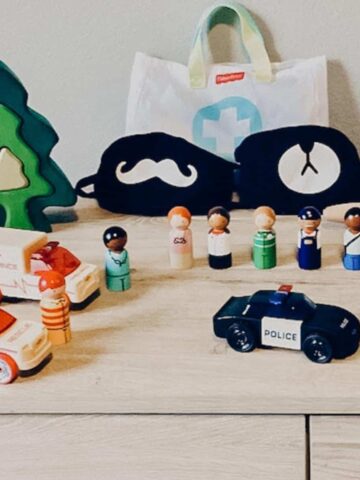
Leave a Reply